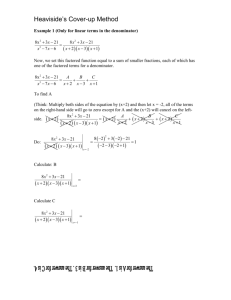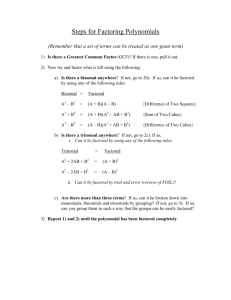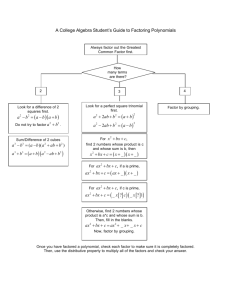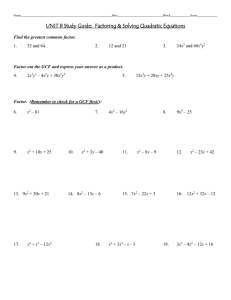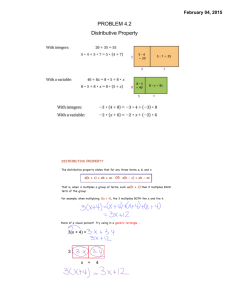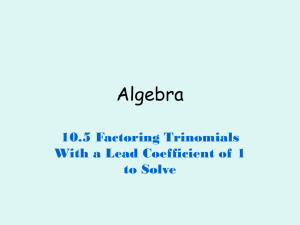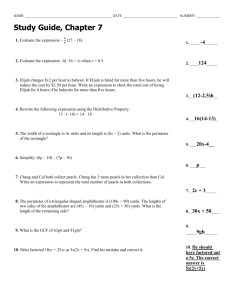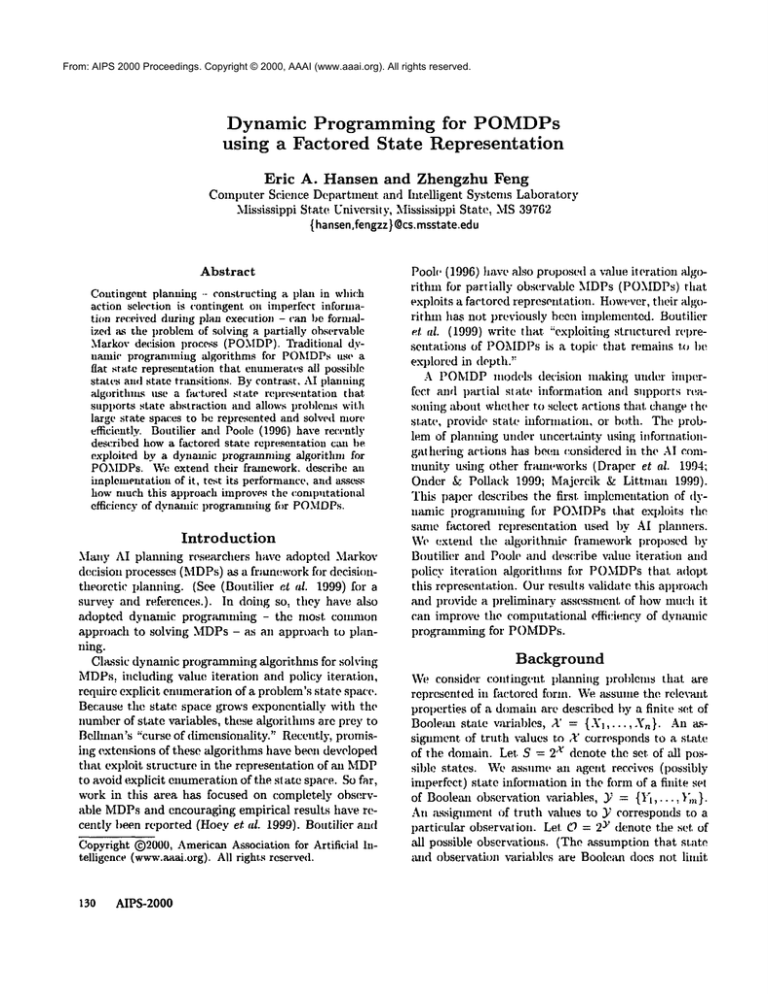
From: AIPS 2000 Proceedings. Copyright © 2000, AAAI (www.aaai.org). All rights reserved.
Dynamic Programming
for POMDPs
using a Factored State Representation
Eric A. Hansen and Zhengzhu
Feng
ComputerScience Department and Intelligent Systems Laboratory
.Mississippi State University, Mississippi State.. MS39762
{ hansen,fengzz}@cs.msstate.edu
Abstract
Contingent planning -- constructing a plan in which
action seh,ction is contingent on imperfect infornlation received during plan execution - can be forma]ized ~s the problemof solving a partially observabh,
Markov decision process (POMDP).Traditional dynamic programmiug algorittmm for POMDPsuse a
flat state representation that enunmrat(.sall possible
states au,l staCe tr~msitions. By contrast, AI plmming
algorithms use a fiwt.ored state rcpres(.ntation that
supports state abstraction and allows prolfloms with
large state spaces to be represented and solved nmre
efficiently. Boutilier ~mdPeele (1996) have recently
described howa factored state rcpresent.ation c~ut be
exploited by a dynamic programmingalgorithm for
POMDPs.We. extend their framework, describe an
implementationof it, test its performance,and assess
how mucl~ this approach improves the computational
effk:iency of dynaanic l)rogrammingfi,r POMDPs.
Introduction
Many AI plamfing researchers have adopted Marker
decision processes (MDPs)as a frmncworkfor decisi,)ntheoretic planning. (See (Boutilier el al. 1999) for
survey and refererlces.).
In doing so, they have also
adopted dynamic programming - the most common
approach to solving MDPs- as an approach to planning.
Classic dyimmic programming algorithms for solving
MDPs,including value iteration and policy iteration,
require explicit enumeratk)n of a problem’s state space.
Because the state space grows exponentially with the
numt)er of state variables, these algorithms are prey to
Belhnan’s "curse of dimensionality." Recently, prornising extensions of these algorithms have been developed
that exploit structure in the rc.presentatkm of an MDP
to avoid explicit enumerationof the sl ate space. So 51r,
work in this area has focused on completely observable MDPsand encouraging empirical results have recen0y been reported (Hoey et al. 1999). Boutilier and
Copyright (~)2000, ArnericanAssociation for Artificial Intelligence (www.aaai.org).All right.s reserved.
130 AIPS-2000
Pool[’ (1996) have also proposed a value iteration algorithm for partially observable MDPs(PO,MDPs)that
exploits a factored representation. H,)wevcr, their algorithm has not previously been imph,Jnented. Boutilicr
et al. (1999) write that "exl)loit.ing strttcturcd r(’prescntations of POMDPs
is a topi(’ that remains ).o I)c
explored in depth."
A POMDP
mod(’ls (lecision m;~king under iml)(:rfeet and partial slat(, information and supports reasoning about whcth,:r to select actkms that change the
state, provide state informaL[ion, or both. The problem of planning under urlcert:tinty using informationgathering act.ions has been considered in the AI community [[sing other fralm,works (Draper et al. 1994;
Ondcr & Pollack 1999; Majcrcik & Lit[man 1999).
This pal)er describes the first implementation of ,lymmfic programming for POMDPsthat exploits tim
same factored representation used by AI planners.
Wec,xteml the algorithmic fl’anmwork proposed t)y
Boutilicr and Pooh, and (tcscribe v~due iteration and
policy iteration algorithms for POMDPsthat adopt
this rcprescnt~tion. Our results validate this al)l*roach
and provide a I)reliminary assessment of how muchit
can improve the computational efficiency of dynamic
programming for POMDPs.
Background
Weconsider (:ontingcnt plmming i)rol)lems tha.t
represented in factored form. Wea~sumethe. relevant
properties of a domainare described tW a finite set of
Boole~mstate variables, A’ = {Xn ..... Xn}. An a,ssignment of truth values to ,~’ corresponds to a state
of the domain. Let. S = 2x denote the set of ~fll possibh: states. Weassume an agent receives (1)ossibly
imperfect) state information in the form of a finit.e set
of Boolean observation variables, y = {YL,...: );n}.
An assigmnent of truth values to Y corresponds to a
l)articulax observation. Let. O = y denote t he s et o f
all possible observations. (The a,ssumption that state
and observation w~riables are Boolean does not limit
From:
AIPS 2000
© 2000,aAAAI
(www.aaai.org).
Allaction
rights reserved.
the results
ofProceedings.
this paper.Copyright
By adopting
suitable
enfor b plus
coding, problems with multi-valued variables call be
represented using Boolean variables.) Wealso assume
a finite set of actions A.
Webriefly review the traditional approach to solving POMDPs
befi~re describing how to generalize it to
exploit a factored representation.
POMDPsFor the class of planning problems we
consider, the n.qationship between an agent arid its environment is modeled as a discrete-tinm POMDP
with
a finite set of states, S, a finite set of observations, O..
and a finite set of actions, A. Each time period, the
environnu.*nt is in somestate s E S, the agent chooses
an action a E A for whic.h it receives an immediate reward with expected value Ra (s) E ~, the environment
makes a transition to state s~ E S with probability
Pr(s’]s, a.) [0, 1] , an d th e agent observes o E O with
probability Pr(ols’, a) E [0, 1]. Weassume the objective is to maximize expected total discounted reward
ow~rart infinite horizon, where/5E (0, 1] is the discount
factor.
Although the state of the environment cannot be directly observed, the probability that it is in a given
state can be calculated. Let b denote a vector of state
probabilities, called a belie~ state, where b(s) denotes
the probability that the system is in state s. If action a
is taken and it is followed by observation o, the successor belief state, denoted boa, is detcrnlined by revising
eat~ state probability using Bayes’ theoreln, a8 follows,
~’]~ses
a)b(
b~(s’) = ~’~s.s,
es Pr(s’,
Pr(s’, o[s,
o1.~,
a)b(s)
where Pr(s’, ois, a) = Pr(s’ls, a)Pr(o[s’, a). now
on, we adopt the simplified notation, Pr(olb, ) =
~-~-s,s, es Pr(s’,°l s, a)b(s), to refer to the normalizing
factor in tile denominator.
It is well-known that a belief state updated by
Bayesian conditioning is a sufficient statistic that summarizes all information necessary for optimal action
selection. This gives rise to the standard approach to
solving POMDPs;
the problem is recast as a completely
observable MDPwith a continuous, ]S]-dimensional
state space consisting of all possible belief states. In
this form, it can be solved by iteration of a dynamicpro.qrammingupdate that performs tile following "onestep ba~up" for each belief state b:
(U
In words, this says that the value ¢ff belief stat.e b is
set equal to the immediate reward for taking the best.
tile discounted expected value of the
resulting belief state boa.
Smallwood and Sondik (1973) prove that this
dynamic-programmingstep preserves the piecewise linearity and convexity of the value function. A piecewisc
linear and convex value function V can be represerit(;d
by a finite set of [S[-dimensional vectors of real numbers, V = {v°, vX,..., vk}, such that the value of eadl
belief state b is defined as follows:
Vfb) = O<i<k
max ~ b(s)vi(s).
(2)
-- sES
Tl,is representation of the value function allows the
dynamic programming update to be computed exactly
and several algorithms for this have been developed
(e.g., Cassazldra et al. 1997). Value iteration repeatedly applies the dynamic-programnling update to
improve a value function until convergence to an eoptimal value function. A policy d mapping belief
states to actions can be extracted from the value function using one-step lookahead, as follows,
Because value iteration represents a policy implicitly
by a value function and improves the policy by gradu’ally improvingthe value function, it is said to "search
in value function space." Another approach to dynamic programming,called policy iteration, is said to
"search in policy space" because it, represents a policy
explicitly and iteratively improves the policy (Sondik
1978; Hmisen 1998)
Planning using factored representations
Unlike
the MDPmodel developed in operations research, AI
planning rescardl has traditionally used factored representations. In the STRIPSaction representation, for
example, actions are modeled by their cffect on state
variables. Whenan action only ’affects a few state v~iahles, or whenits effects are very regular, the STRIPS
description of the transition modelof the action can be
very compact even if the state space of tile planning
problem is very large.
The representations used by AI planners were originally developed for classical planners that ignored uncertainty, such as the STRIPSplanner. In the past
few years, tlmre has been growing interest it, generalizing these representations to planning probleins
that include uncertainty about the effects of actions
and/or uncertainty about the problem state. A nonlinear planner that solves planning problems that include both forms of uncertainty is described by Draper
Hansen 12} I
.~_______________2~~
~ ..." "_.~. , 1-I."
From: AIPS 2000 Proceedings. Copyright © 2000, AAAI (www.aaai.org). All rights reserved.
et el. (1994). Onder and Pollack (1999) describe
provements to this "algorithnl. Majercik and Littman
(1999} describe a satisfiability-based
planner for tlle
smile class of planning problems. Boutilier and Peele
(1996) propose exploiting the factored state representation used by such planners to improve the efficiecy
of dynamic programnfing for POMDPs.
¯ .. t~"’..
¯""
f~,. --.~ ...._..~ f-~...~... ""-
Factored representation
of POMDP
The advantage of using a factored state representation
is that it allows a powerful form of state abstraction
in which an abstract stat.c is a partial assignment of
truth values to X and corresponds to a set of possible states in the flat representation of the probh,nl.
Using abstraction to ignore properties of the state in
contexts where they are irrelevant makes it possible
to specie" a transition and reward model for actions
more compactly, a,s well as to accelerate the dynamic
progranzming algorithm.
132
AIPS-2000
SH RI" "40 I PA’
,
,
F T,I-"
F I",’F "l’/!’
~~--~--~’~
Decision diagrams To represent
fimctions that
map states to vahms {or probabilities),
traditional
POMDP
~dgorithms use a vector that represents each
mapping from state to vahm independently. Boutilier
and Peele (1996) propose using decision trees to compax:tly represent these fimctions. By mapping sets of
states with the same value to the same leaf of the
tree. decision trees can compactly represent the sam(,
functions. Boutilier and Peele note that other compact representations an’ possible, including rules amt
decision lists, and Hoey et al. (1999) have recently
shown that algeb~n.ic decision diagrams (ADDs) (:an
compactly represent the transition prol)abilities,
reward function, value function and policy of an MDP.
They describe a value iteration algorithm for cumpletely observable MDPsttmt uses this representation
a~z(t report that it OUtl)erformsa similar algorithnl that
uses decision trees to compactly represent an MDP.We
also use ADDsin our algoritlml K~r solving factored
POMDPs.
Decision diagrmns are widely used in VLSI CADl)ccause they make it possible to represent and evaluate
large state space systems (Bahar et el. 1993). A binaxy decision diagram is a conllm(:t representation of
a Boolean function, /3" -~ /3. An algcbralc decision
diagram (ADD)gem’.ralizcs a binary decision diagram
to represent real-valued functions,/3" ~ ~. Figures 1,
2, and 3 include examples of ADDs. An ADDcan be
more compact than a decision tree because it merges
branches that lead to the same value. Efficient packages for manipulating ADDsare available that provide
operations such as sum, product, expectation, and others (Sornenzi 1998).
T~
. +°,
I F O0
OO
/
Figure 1: Fettered represontatioa of transition prolml~ilities for imint action.
Example As an exanlple of a POMDPwith a factore(t representation, we use a variation of the widgetprocessing ex+mtple of Draper ctal. (1994). Our version of this problem has six Boolean sta.t<~ variabh,s.
A widget can be flawed (FL), slightly flawed (SL-FI+),
painted (PA), shipped (SH), and/or rejected (RE), and
a supervisor can be notified (Nf)) that tile widget,
been processed. A manufacturing robot has six available actions. It can inspcct, re.pair., paint, ship, or reject
the widget, and it can verify a supervisor that the widget. has been processed. Tile objective of the robot is
to paint and ship any widget that is not flawed and
rqiect ~mywidget that is flawed. If a widget is only
slightly flawed, it can be repaired (removing the slight
tlaw) and then painted and slail)ped. (llowt,ver, t.he
repair and paint actions are only succ(,ssful with probability 0.95.) The inspect action provides imt)orfoct information +0)out whether a widget is flawed or slightly
flawed. There are two observation variables, BAD+.ml
SL-BAD.If a widget is flawed, the BADvariable is true
with probability 1.0; if it is not flawed, it is t.ruc wit.h
probablity 0.05. If a widget is slightly flawed, the SLBADvariable is true with probability 0.95; if it is not
slightly flawed, the SL-BAD
wtriable is false with probability 0.0. (But if the widget is flawed, the SL-BAD
variable is always false.) Aftcr the robot ilas processed
a widget, it nol.ifies the supervisor. It receives a reward of 1.0 for shipping a widget that is unllawed ~utd
painted, and a reward of-l.0 for shipping a flawed widget. After notifying the suimrvisor, the robot receives
another widget to process. The probability that the
next widget is flawed is 0.3 madthe probability that it
is slightly flawed is 0.3. All the other state variables
are initially false. This examl>le models a simple "assembly line" in which a robot must process an infinite
sequence of widgets and its objective is to maximize
cumulative discounted reward over an infinite horizon.
The discount factor is 0.95.
From: AIPS 2000 Proceedings. Copyright © 2000, AAAI (www.aaai.org). All rights reserved.
...’"
.....
~
RF,?ARD
FL’ [ BAD
. .......
T/~FI 0.05
-~............
.~L-¢,-"""n~
SL-BAD
\f__~ ........ ~, s~__~.
~n= 0.0 .....
Cs~., ~-----~SL.S^D~:
T
~ ’"...
F
T
"" F
F
I|.
0.0
o.9~
"’"~ o
I .O
"
"’’.
0.0
-I .O
ADDRepmsmlafion
Figure 2: Factoredrepresentationof observationprobabilities for inspectaction.
Figure 3: Factored representation of reward function for
noti~- action.
Conditional
probability
functions
A factored
representation
of a POMDP
allows state transition
and observation probabilities to be represented compactly. Like Hoey et al. (1999), we represent state
transition and observation probabilities using two-slice
dynamic belief networks. A two-slice dynamic belief
network for action a has two sets of variables, one set
2l = {XI ..... Xn} refers to the state before taking action a, and X’ = {X~, ...,Xr, rl } refers to the state after.
Directed arcs from variables in X to variables in X’
indicate causal influence. The absence of arcs from
variables in A" to variables in XI reflects variable independence, which allows the state transition probabilities to be represented more compactly. The conditional
probability table for each post-action variable X~ defines a conditional distribution Pa(X~IX) over X~ for
each instantiation of its parents. Instead of representing these conditional probabilistics as a table: we follow
Hoey et al. in representing them using ADDs.(This
type of representation is said to exploit context-specific
or value independence, in addition to variable indepcndence.) Figure 1 illustrates
a dynamic belief network
representation of the paint action.
Weuse a similar factored representation for observation probabilities, as illustrated in Figure 2. Observation probabilities are defined scparately for cach action. The state variables in the network represent the
state that results from the action associated with this
network; only the relevant state variables are shown
in this network. The conditional probabilities of the
observation variables depend on the values of the state
variablcs
Recall that Pa(X~K2d
) denotes the transition probabilities for statc variable X~ after action a. Welet
P" (X’[X)P~(X~]2d)...P~ (,X" ~ 12d)denote the t razl sition probabilities for all state variables after action
a. It is represented by an ADDthat. is the product
of the ADDsrepresenting the conditional probabilities
for each state variable. Similarly, we let Pa’°(X’[X) denote the transition probabilities for all state variables
after action a and observation o. It is defined in a similar way using the product operation for ADDs.Hoey
et al. (1999) describe in detail how to use ADDs
compute transition probabilities in the completely observable case. It requires defining both negative action
diagrams and dual action diagrams before performing
the product operation on these ADDs.For reasons of
space, we refer to that paper for details.
Reward and value functions
The reward function for each action, denoted R’~, is also a statevalue fimction and can be represented compactly by
an ADD.This is illustrated
in Figure 3. Because
a piecewise linear and convex value function for a
POMDP
is repesented by a set of state-value functions
V = {vn,’v I,...,vk},
it can also be represented compactly by a set of ADDs.In tim rest of this paper, we
describe howto exploit a factored representation of a
piecewise-linear and convex value function for computational speedup.
Dynamic
programming
update
The central step of dynamic progranmfing algorithms
for POMDPsis the step that updates the piecewise
linear and convex value function based on a one-step
backup for all belief states, as expressed by Equation (1). Several algorithms have been developed that
perform this computation. Boutilier and Poole (1996)
describe how the simplest of these, called Monahan’s
algoriLhm, can exploit a factored representation. In
this section, we describe howthe most efficient of these
algorithms., called incremental pruning, can also exploit a factored representation. Webegin with a brief
review of incremental pruning before describing how it
can be generalized to use a factored representation.
In their description of incremental pruning, Cassandra et al. (1997) note that the updated value function
V’ of Equation (1) can be d(~fined as a combination
Hansen 133
From:
AIPS value
2000 Proceedings.
© 2000, AAAI (www.aaai.org). All rights
reserved.
Backup
The
simpler
functions, Copyright
a,s follows:
V’(b)
=
backup step uses one-step lookahead to
create new state-value functions, given a current value
flmction ]2 and the transition and reward functions of
the problem. First, it creates the state-vahm functions
in each set ];,,o. For state-vahm functions represented
in flat form, Equation (3) dcfines tmwthe state-value
funct ions in ]2"’° arc created. For state-value flmctions
in fa~:tore(t form, the following equation does the same:
maxV"(b)
aEA
= y"’°(b)
oEO
V"’"(b)
= ~’~e.~ Ra(s)b(") + flPr(olb, a)l..,(b~)
IOi
Each of these value functions is piecewise linear and
convex. Thus, there is a unique minimum-size set of
state-value functions that represents each vMuetimelion. Weuse the symbols V’, V", and ]/a,o to refer to
these minirnum-size sets. Weuse the symbol ~; to refer
to the mininmm-sizeset of state-value flmctions that
represents the current wtlue fimction 1".
Using the script letters 14 and Wto denote sets of
state-value funetkms, we adopt the following notation
to refer to operations on sets of state-vahm fimctions.
The clvss sum of two sets of state-value filnctions. 14
and W, is denoted 14 :? W = {u + wlu e 14, w ¯ W}
Aa operator that takes a set of stat(~-value functions
H ~md reduces it to its unique minimumform is (lenoted PRUNE(H).Using this notation, the minimumsize sets of state-value functions defined earlie.r can l)c
characterized as follows:
Y’
Y"
Y"’°
=
=
=
PRUNE(U,,e.412’)
PRUNE (~,eoV"’")
PRUNE({v"’""l v’ ¯ V}),
where
t ....... i is the state-vahm fimction defined by
v,,,o,i(~)_ R"(s)+ i~ Z Pr(s’, ols, a)t"(s’),
IO---F
(3)
s’C:’,"
Incremental pruning gains its efficiency (and its name)
from the way it interleaves pruning and cross-sum to
compute Va, as follows:
1; ~ = PRUNE(...(PRUNE(V"’°’
:.-0 l, ’~’°2 )...
~ ~,,.o~ ).
Cassandra et el. (1997) describe restricted re gion
generalization of incremental pruning that improves
the efficiency of the algorithm Mrther. We(it) not describe it here because it presents no fllrther compli(’ation for use of a factored representation.
Only two steps of the incremental pruning algorithm
must be nmdified to exploit a factored representation:
the backup step that creates each v a’°’~ (and later
comtfincs thexn using the cross-sum operator) and the
pruning step. Below, we describe how to rnodi~" these
two steps. The rest of the algorithm works exactly the
same using a factored representation as it does using a
flat representation.
134 AIPS-2000
v.....~(,v)-
R"(X)
I0~ +/Jx,~ P"’%V’I,V)v~(A’’) (4)
[n this equation, vTM, R’~, p,,.o, and vi are represented by ADDs.The operators used in this equation
include product of two ADDsand sum of two ADDs.
(Multiplication and division of an ADDby a scalar
is implemented by first, conw:rting the scalar to an
ADDrepresentation
and then computing the product
of two ADDs.)In addition, the syrnhol ~"]-x’ denotes
~moperator that eliminates the primed state variables
in the product ADD,P"’°(,~"lA’)v i(,V,), by summing
over their values. (In the ADDpackage, this operant.or is called existenti~fl abstraction.) This operator
makes it. possible to compute an expected value at the
level of state variables instead of states. Once these
state-value functions have been created, the cross-sum
opt’rater - which simply sums the state-value functions
ret)resented by A DI)s - is used to create the state-value
flmctions that are eventually cont~fined in ~;’.
This backup step for POMDPs
is very similar to the
dynmrnic programming update step for completely ohservable MDPsin factored form, as described by ltoey
et el. (1999). The only difference is that observations azld observation probabilities are included in the
POMDP
version axld the maximization operator is not.
Given this close correspondence, we refer to their paper for a detailed explanation of how to implement
this backup step using a factored representation, such
as ADDs.The generalization of tiffs step to POMDPs,
assuming a decision tree representation of state-value
functions, is described by Boutilier and Peele (1996).
Boutilier and Peele also suggest that the pruning step
of POMDP
algorithms can exploit a factored representation, although they do not develop an ,’flgorithm for
this. To complementtheir paI)er, we proceed to discuss
this pruning step at length.
Prune The operator PRUNE(.) takes a set of statevalue functions as input ~mdremoves donfinated statevalue fim(:tions from it, that is, state-value flmt:tions
whose removal does not change the belief-value fimction represented by the set of state-value functions.
The simplest method of removing donfinated statevalue functions is to renlove any state-value fimction
From: AIPS 2000 Proceedings. Copyright © 2000, AAAI (www.aaai.org). All rights reserved.
procedure
POINTWISE-DOMINATE(w,/4)
for each u E L/
if w(s) <_ u(s), Vs th enretur n true
return false
procedure LP-DOMINATE(w,/4)
solve the following linear program
variables: d, b(s) Vs ¯ S
maximize d
subject to the constraints
b.(w-u)>d,
Vu¯H
~,esb(s) =
if d > 0 then return b
else return nil
procedure
BEST(b,U)
for each u ¯/4
if (b- u > max) or ((b-u max) and (u <zez w)) then
max~-- b . u
return w
procedure
PRUNE(/4)
]4.’ ~ 0
while/4 ¢ 0
u ~-- any element in/4
if POINTWISE-DOMINATE(u, W) = true
U ~ U - {u}
else
b e- LP-DOMINATE(u, W)
if b = nil then
U +- U- {u}
else
w +--BEST(b,/4)
W ~ W o {w}
U ~- U - {w}
returnYV
Table 1: Algorithm for pruning a set of state-value
functions represented by vectors.
that is pointwise donfinated by another state-value
flmction. A state-value function, u, is pointwise dominated by another, w, if u(s) _< w(s) for all s ¯ S. The
procedure POINTWISE-DOMINATE
in Table 1 performs this operation. Although this method of detecting dominated state-value functions is fast, it cannot
detect all dominated state-value functions.
There is a linear prograznming method that can detect all dominatedstate-value functions. Given a statevalue function v and a set of state-value fun(’tions/4
that doesn’t include v, the linear program in procedure LP-DOMINATE
of Table 1 determines whether
adding v to/4 improves the value function represented
by/4 for any belief state b. If it does, the variable d optimized by the linear program is the maximumamount
by which the value fimction is improved and b is the
belief state that optimizes d. If it does not, that is: if
d _< 0, then v is dominated by/4.
Tabh: 1 summarizes an algorithm, due to White and
Lark (White 1991), that uses these two tests for dominated state-value functions to prune a set of statevalue functions to its minimumsize. (The symbol <le,
in the pseudocode denotes le_xicographic ordering. Its
significance in implementing this algorithm was elucidated by Littman (1994).) To use this algorithm
prune a set of state-value functions represented in fi~(:tored form, we first perform the pre-processing step
summarized in Table 2. It takes as input a set of
state-value functions represented in factored form and
creates an abstract state space for it that only makes
the state distinctions relevavt for predicting expected
walue. Because an abstract state corresponds to a set of
underlying states, the cardinality of the abstract state
space can be muchless than the cardinaiity of the original state space. By reducing the effective size of the
state space, state abstraction can significantly improve
the efficiency of pruning because the complexity of
the three subroutines used in pruning - POINTWISEDOMINATE,LP-DOMINATE,and BEST - is a filnction of the size of the state st)ace. (In the case
the linear programmingtest for dominated state value
flmctions, state abstraction reduces the numberof variables in the linear prograzns.)
In the pseudocode for CREATE-PARTITION,
R denotes a set of abstract states, hfitially, R contains
a single abstract state that corresponds to the entire
state set of the problem. Gradually, R is refined by
nraking relevant state distinctions. Each new state distinction splits some abstract state into two abstract
states. Th(: algorithm (toes not backtrack; every state
distinction it introduces is necessary and relevant.
Each state-value flmction represented by all ADD
defines an abstraction of the state space where the
mnnber of abstract states is equal to the number of
leaves of the ADD,and each abstract state represents
a set of underlying states with the same value. Given
a set of state-value functions (represented by ADDs),
the algorithm summarized in Table 2 creates a set of
abstract states that is consistent with the abstractions
of the state space created by each state-value function.
This meea~s that. whenever two states are mapped to
different values by the same state-value flmction, they
must belong to different abstract states in R.
Hansen 135
From:procedure
AIPS 2000 Proceedings.
Copyright © 2000, AAAI (www.aaai.org). All rightsBesides
reserved.
CREATE-PARTITION(V)
creating
R+- {S}
for each state-value function v 6 V
T ~ set of abstract states defined by ’v
for each abstract state l 6 T
for each abstract state r 6 R
if (t A r = 0) or (r C_ t) then do nothing
else if t C 7" then
R R - {r}
a RU {0 U {r - t}
exit innermost for loop
else
R R- {r}
a RU{r - t} U{r n t}
T +-- TU {t- r}
exit innermost for loop
return
R
Talfle 2: Algorithmfor partitioning a state set.. S, into
a set of abstract states, R, that only makes relevant
state distinctions found in a set of factored state-value
functions, V.
Table 2 describes the CREATE-PARTITION
algorithln as if the abstract states it manipulates correspond to sets of underlying states, mL(1conceptually
this is true. But in our implementation: we represent
abstract states by binary decision diagrmns (BDDs)
that partition the state set into two sets of states, those
that mapto 1 arid those that map to 0. Wedefine the
set of underlying states that corresponds to the abstract state represented by a BDDd as follows:
Sd= {sld(s) = 1, s S}.
This representation of abstract states allows Boolean
set operations provided by the ADDpackage to be
used in implementing the algorithm for partitioning
the state space into abstract states. Weuse the logical
ANDoperator, where
dl&d~.(s) = 1 if and only if dl(S) = 1 and d2(s) = 1,
and the logical complement operator,
where
([1 (s) = 1 if an only if dl (s)
to define the following operationsazl(l relations on sets
of uriderlying states correspondingto abstract states:
Sa, A Sa.~
Sa, - Sa.~
St, c_ Sa~
Sa~ASd2 =0
136 AIPS-200O
=
=
if
if
Sa,aa~
Sa~az~.
dl&d.., = dl
dl&d.~ =0
an abstract state space, our impk.mentation of this pre-processing step returns a w~ctor
representation of the set of state-~due flmctions, where
the size of each vector is equal to the number of abstract states. (Vectors defixmdover abstract states can
be mu(’h smaller th,’m vectors defined over the taMerlying states; so this is not a fiat representation of the
set of state-vahm flmctions.) Wedo this becaus,, the
pruning algorithm runs much faster when state-value
functions are represented as vectors than when th(:y
are represented as ADDs.As long as the vectors are
defined for abstract states, I)oth the vector and ADD
representations art: equally (’ompact. (This temporary
change of representation also ha~ the ben,,iit of alh)wing t, ho flat and factored algorithms to use the same
code fi)r framing sets of stare-value functions. Thus,
the differences in running tilnc reported later are not
clouded by imtflenmntation differences and accur.’m,ly
reflect the benctlts of state abstraction.)
The algorithm for creating anabstract sta.t.e sl);Lcc
sulnmarized in Table 2 has a worst-case complexity
of ]V]IS]", allhough it rims mu(’hfa.st(,r whenthere
sl ate abstraction. (It is easy to imaginea fa.su.r heuristic algoritt,m that finds a us~flfl, though not necessarily best. state abstraction. For the examples we haw,
tested so far, we have not fouud this necessary.)
Value
and policy
iteration
V~dueiteration for POMDPs
consists of repeatedly applying the dynami(: t)rogramming ul)date. W(,
also used a factored state representat ion in implernenting a policy iteration algorithm fi)r POMDPs
that represents a policy as a finite-mat(: controller (]lansen
1998). By interleaving the dynamic programming Ul)date with a policy evaluation step., this algorithm can
converge in fewer iterations than ~flue iteration. The
policy evaluation step of the algorithm exploits a factored state representation by using a successive approximation algorithm similar to that described by
Boutilier et al. (1995) to evaluate a controller.
For infinite-horizon
POMDPs.the error bound of
a value function is computedby solving a set of linear
prograzns. Computationof tile error bound can also be
accelerate(] by cxpk)iting a fimtore(1 state representation, using the same algorithm fi)r creating an abstract
state space summarized in Table 2. Space limitations
preclude us from describing this here. But we note that
the time it takes to compute the error bound is very
small, aad ahnost negligible, (’ompared to the time it
takes to compute the dynmnic programming update.
For the widget processing example, value iteration
converges to an optimal belief-value flmction consisting of 33 state-vahm flmctions and policy iteration
From: AIPS 2000 Proceedings. Copyright © 2000, AAAI (www.aaai.org). Alltotal
rights reserved.
time is slightly
|NSPF.CI" -BAD,-$L-BAD
Figure 4: Optimal controller for widget-processing problem (showingonly recurrent nodes).
converges to an optimal finite-state controller with 33
nodes. Figure 4 shows the recurrent nodes of the controller, that is, the nodes that are reachable after a
widget is processed. The other 27 nodes are transient
nodes that are only useful for initial probability distributions that differ from those r.hat characterize the
initial condition of the widget. The controller in Figure 4 represents an optimal assembly-line plan for the
robot.
Test
results
Wecompared tile performance of our implementations
of incremental pruning using a factored and a flat representation. Both implementations are identical except
that the factored algorithm uses ADDsto compactly
represent transition and observation probabilities and
state-value functions, while the flat algorithm uses vectors and explicitly represents all states.
Table 3 compares one iteration of incremental pruning using the factored and flat representations, for
seven different POMDPs.
The results for the flat representation are shownabove tim results for the factored
representation. Both algorithms have the same input
and compute identical results. Both perform the same
number of backups, the same number of pruning operations, the same number of linear programs, etc. They
only differ in the data structures they use.
The procedure PRUNEis invoked multiple times by
incremental pruning. Each time it is invoked by the
factored algorithm, an abstract state space is created
by the procedure CREATE-PARTITION.The column
with the heacling "Abs" indicates the average cardinality of the abstract state sets that are created. In
general, the higher the degree of abstraction for a problem, the faster the factored algorithm runs relative to
the fiat algorithm. The relationship between degree of
abstraction arid computational speedup is complicated
by other factors, however, including the cardinality of
the set of state-vahm functions and the number of observations. Wehave broken downthe timing results to
help illustrate the effect of these various factors. (The
larger than the sum of the times
for all the operations; this reflects a slight ow~’rheadin
the algorithm for setting up the computation.)
Problem1 in Table 3 is the coffee problem used as all
illustration by Boutilier and Poole (1996). Problem3
the widget-processing problem used as an illustration
in this paper. The other problems are various synthetic
POMDPs
created for the purpose of testing. Problem
4 illustrates the worst-case behavior of the algorithm
when there is no state abstraction. Problem 2 illustrates the performance of the algorithm where there
is a very nmdest degree of state abstra~:tion. Problems 5, 6, and 7 illustrate the performanceof the algorithm when there is a high degree of state abstractkm;
they represent close to the best-case behavior of the
algorithm for problems of their size. As problem size
increases, that is, as the cardinality of S, G, and V
increases, the potential speedup from using a factored
representation increases as well.
Twosteps of the incremental pruning algorithm exploit a factored representation: the backup step and
the pruning step. The table breaks downthe timing results for each step. Within each step, it times each operation that uses a factored representation separately.
This makes it possible to determine the relative contribution of each operation to the running time of the
algorithm, as well as the relative performance of the
operations using the factored and flat representations.
The backup step for POMDPs
is similar to ttm dynamic progrmnming update for completely observable
MDPsrepresented in factored form. Like Hoey et al.
(1999), we found that its worst-case overhead cml cause
a factored backup to run up to ten times slower than a
flat backup. This is illustrated by problem 4. But also
like Hoey et al., we found that factored backups can
run mud1faster than flat backups whenthere is sufficient state abstraction. This is illustrated by problems
6 and 7, in particular.
For most POMDPs,and for all POMDPsthat. are
difficult to solve, most of the ruiming time of dynamic
progranmfingis spent pruning sets of state-value functions. In our implementation, the only overhead for
the factored pruning algorithm is the overhead for creat.ing an abstract state space. Empirically, we found
that this overhead is quite small relative to the tutoring
time of the rest of the pruning algorithm. Although it
tends to grow with the size of the abstract state space,
problem 4, our worst-case example, does not illustrate
the worst-case overhead. This is because the procedure CREATE-PARTITION
has a useful and reasonable optimization; as soon as the cardinality of the
abstract state space is equal to the cardinality of" the
underlying state space, it terminates. For CI~EATE-
Hansen 137
Problem Copyright © 2000,
From: AIPS 2000 Proceedings.
AAAI (www.aaai.org).
All rights reserved.Timing
Solution
~
~
characteristics
[
II Backup
IV[ IV’ I Abs
New Xsum Part
0.4
0.08
3 21
91
229 14.0
1.1
0.92
9.8
0.2
0.19
25
142 20.9
0.2
8.6
6 22
0.48
1.1
0.00
32
6 2"
30
7.5
0.6
0.02
0.6
53.4
0.09
5 2"
521 2539 64.0
395.6
8.39
1.8
7.5
0.12
42
42
12.8
56
{}.15 3.8
8 22
- 4113.1 1..11
11 2 :~ 198 457 34.6
225.3
0.25 63.4
0.24
132.5
’t
11 2
4 255 8.9
0.06 1.0
3.0
characteristics
1
’~
2
2
s2
I
3
26
] 4
i
5
~
2
r2
6 21°
7 2 t°
Results
Prune
Ptw
1.96
2.53
23.55
30.11
0.02
0.01
17.97
17.6-t
0.30
0.22
2.44
2.40
0.10
0.06
LP
480.6
343.7
3640.3
3471.4
5.4
2.7
7957.8
8072.1
133.0
30.5
8099.1
641.8
622.5
22.,t
[
Best
15.36
7.50
166.73
102.54
0.14
0.07
152.02
152.79
12.94
0.92
32.1.89
19.82
25.97 I
0.52 [I
Total
366.3
3831.8
3615.3
6.7
4.0
8181.9
8653.2
154.2
41.4
12546.1
959.7
782.0
27.0
Table 3: Timing results (in CPUseconds) for an iteration uf the dynamicprogrammingupdate using increment’,fl pruning.
Resul|s for the fiat representation are shownaboveresults f. r tile factored representation. The (’olumnwith the heading
"Abs" represents the nn,ml numberof abstra~’t states, wh:c!, is averaged over all calls to the procedure PRUNE.
"New"
i. "Xsum"
representsthe timefor computing
Equation(4) (for the fac.,o::,d ,:a,se) mtd(3) (tbr the flat case) to create ",all
represents the time for computingcross sums."Part" represexr:,,, the time for partitioning the state space into abstract states.
"Ptw" represents the time for pointwise dominancepruaing "LP" represents the dine for linear programpruning. "Best"
repre^sents the time for the procedure BEST.
PARTITION
to incur its worst-case overhead, in other
words, there must be at least some state abstraction.
But this, in turn. can offset the overhead.
For probhml 3, there is an apparent mmnmlyin the
timing of the pointwise dotninance test; it is slightly
slower using a factored representation. The explanation is that the algorithm for detecting pointwise dominance is optimized to terminate as soon as one vector
does not donfinate the other for some state. Thus, the
order of states can affect the timing of this algorithm.
’although it does so by chance. Because abstract states
can be ordered differently than flat states, the running
time of the pointwise dominancetest is not faster in
every case, using a factored representation.
Our results show that exploiting a factored representation for state abstraction can significantly accelerate the pruning algorithm. It can reduce the running
time of the pointwise dominancetest by decreasing the
number of state values that are compared (although
our results do not illustrate this weU); it can reduce
the running time of linear programmingby decreasing
the numberof variables in the linear progranls; and it
can reduce the running time of the procedure BESTby
decreasing the size of the vectors for which a dot product is computed. Because most of the running time of
dynanfic programmingis spent pruning sets of statevalue functions, especially using linear programming,
138 AIPS-2000
int:renmntal I)runing using a factored reprcscntation
can run significantly faster than using a fiat represent ation. Moreover,it incurs very little overhead, even in
the worst case. Our results suggest that the worstcase overhead fi)r a factored dynamic progranmfing
algorithm for POMDPs
is considerably less than the
worst-case overhead for a factored dynamic programruing algorithm for completely observable MDPs(Hoey
et al. 1999). The ba(~up step for both algorithrns may
incur the santo overhead. However, the rumfing time
of dynamic programming for POMDPs
is taken up primarily by pruning sets of state-value functions. This
step incurs very little overhead, and thus the combined
overhead for the POMDPalgorithm can be a much
smaller fraction of the ~flgorithm’s rurming time.
Discussion
Wehave described an implementation of dynaznic progranmfing for POMDPs
that exploits a factored state
representation. It is based on, and extends, a framework proposed by Boutilier and Poole (1996). Weexte.nd their fraznework in the following ways; we use
ADDsinstead of decision trees, we show how the incremental pruning algorithm (the fastest algorithm for
computing the dynamic programming update) cml exph)it a factored ret)resentation, and we describe an algorithm for creating an abstract state space that accelerat(:s the pruning step of dymmfic progrmnming. Our
From:
AIPS 2000
Proceedings.
© 2000,
(www.aaai.org). All rights
reserved.C.
test results
indicate
that Copyright
a factored
stateAAAI
representaBoutilier,
tion cazl significantly speed up dynamic programming
in the best case and incurs little overhead in the worst
case.
This positive result must be placed in perspective,
however. The approach we have described addresses
POMDP
difficulty that is due to the size of the state
space. For completely observable MDPs,the size of the
state space is the principal source of problemdifficulty.
For POMDPs,
it is not. Although tile size of the state
space contributes to POMDP
difficulty~ the size of the
value function representing a solution to a POMDP
can have a larger influence on problem difficulty.
A
POMDPwith a large state space may have a small
optimal value function that can be h)und quickly. By
contrast, a POMDP
with a small state spax:e may have
a large or unbounded value function that is computation,~ly prohibitive to compute. Although the fraznework we have described for exploiting a factored state
representation can be very beneficial, it does not address the aspect of POMDP
difficulty that relates to
the size of the value function.
Boutilier and Poole (1996) propose a related approach to approximation that uses a factored representation of state-value functions to represent bounds
on state values. By ignoring state distinctions that
have little effect on expected vahm, this approach can
reduce tile size of the value fimction computedby dynamic programming. Weplan to experiment with this
approach to approximation in the near future. We
will also explore the possibility of exploiting the factored representation of observations to achieve additional computational speedup.
Acknowledgements We thank the anonymous re-,
viewers for helpful comments.
References
Bahar, R.I.; Frohm, E.A.; Gaona, C.M.; Hachtel,
G.D.; Macii, E.; Pardo, A.; and Somenzi, F. 1993.
Algebraic decision diagrams and their applications.
International Conference on Computer-Aided Design,
188-191, IEEE.
Boutilier, C.; Dean, T.; and Hanks, S. 1999. Decisiontheoretic planning: Structural assumptions and computational leverage. Journal o] Artificial Intelligence
Research 11:1-94.
Boutilicr,
C.; Dearden, R.; and Goldszmidt, M.
1995. Exploiting structure in policy construction. In
Proceedings of the Fourteenth International Conference on Artificial Intelligence (IJCAI-95), 1104-1111,
Montreal, Canada.
and Poole, D. 1996. Computingoptimal
policies for partially observable decision processes using compact representations.
In Proceedings of the
Thirteenth National Conference on Artificial Intelligence (AAAI-96), 1168.1175. Portland, OR..
Cassandra, A.R.; Littman, M.L.; and Zhang, N.L.
1997. Incremental pruning: A simple, fast, exact
method for partially observable Markovdecision proccsses. In Proceedings of the Thirteenth Annual Conference on Uncertainty ill Artificial Intelligence (UAI97). 54-61, Providence, RI.
Draper, D.; Hanks, S.; and Weld, D. 1994. Probabilistic planning with information gathering and contingent execution. In Proceedings of the Second International Conference on Artificial Intelligence Planning
Systems (AIPS-94), 31--36.
Hansen, E. 1998. Solving POMDPsby searching ira
polic.y space. In Proceedings of the Fourteenth Conference on Uncertainty in Artificial Intelligence (UAI98), 211 219. Madison, WI.
Hoey, J.; St-Aubin, R.: Hu, A.; and Boutilier, C.
1999. SPUDD:Stochastic Planning using Decision
Diagrams. In Proceedings of the Fifteenth Conference on Uncertainty in Artificial Intelligence (UAI99), Stockhohn, Swcden.
Littman, M.L. 1994. The Witness algorithm: Solving partially observable Markovdecision processes.
Brown University Department of Computer Science
Technical Report CS-94-40.
Majercik, S.M. and Littman, M.L. 1999. Contingent
planning under uncertainty via stochastic satisfiability. In Proceedings of the Sixteenth National Conference on Artificial Intelligence (AAAI-99),549-556,
Orlazldo, FL.
Onder, N. and Pollack, M.E. 1999. Conditional, probabilistic planning: A unifying algorithm and effective
search control mechanisms.In Proceedings of tile Sixteenth National Conference on Artificial Intelligence
(AAAI-99), 577 - 584, Orlando, FL.
Smallwood, R.D. and Sondik, E.J. 1973. The optimal
control of partially observable Markovprocesses over
a finite horizon. Operations Research 21:1071-1088.
Somcnzi, F. 1998. CUDD:CUdecision diagrmn package. Available from ftp://vlsi.colorado.cdu/pub/.
Sondik, E.J. 1978. The optimal control of partially
observabk~’Markovprocesses over the infinite horizon:
Discounted costs. Operations Research 26:282-304.
White, C.C. 1991. A survey of solution techniques
for the partially observ(:d Markovdecision process.
Annals o/ Operations Research 32:215 230.
Hansen 139

